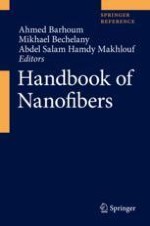Abstract
Over the past few years, there has been a tremendous increase in the demand for polymeric nanofibers which are promising candidates for various applications including tissue engineering, blood vessels, nervous system, drug delivery, protective clothing, filtration, and sensors. To address this demand, researchers have turned to the development of various techniques such as several non-electrospinning and several electrospinning techniques for the fabrication of nanofibers. In this chapter, a comprehensive and systematic review covering all the techniques used to produce nanofibers have been discussed. Some of the techniques include drawing techniques, spinneret-based tunable engineered parameter (STEP) method, phase separation, self-assembly, template synthesis, freeze-drying synthesis, and interfacial polymerization of nanofibers. The electrospinning technique is well referenced for its effectiveness in the production of nanofibers. The past two decades have witnessed the development of the traditional electrospinning technique, and many derivative methods have been emerged such as multi-jet electrospinning, needleless electrospinning, bubble electrospinning, electro-blowing, cylindrical porous hollow tube electrospinning, melt electrospinning, coaxial electrospinning, forcespinning, flash-spinning, self-bundling electrospinning, nanospider electrospinning, charge injection electrospinning, etc.
This chapter also highlights some of the advantages and disadvantages of each production process. In addition, schematic diagrams of various methods for nanofiber production and the features of nanofibers that can be produced using each technique are illustrated.
